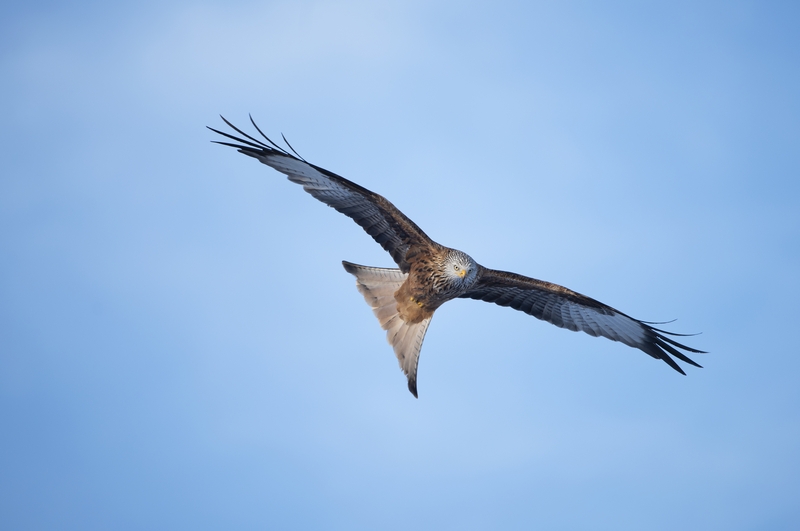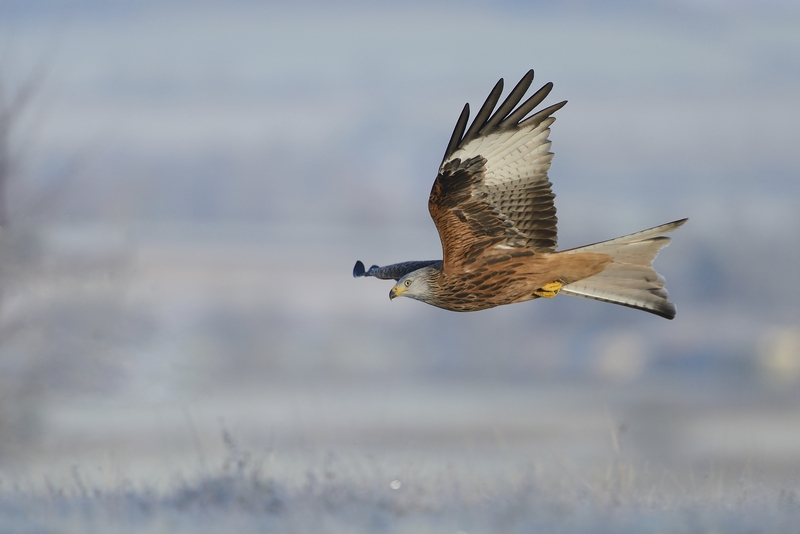
The UK’s most successful bird conservation project – for red kites – has come full circle and is now donating kite chicks to a similar project in Spain, the country that provided chicks for our red kite reintroduction project to England almost 35 years ago.
In 1989, an ambitious project began to restore red kite populations in England and Scotland after they had become extinct around the 1870s, having suffered relentless human persecution by gamekeepers, skin and egg collectors. Now, conservationists are delighted that the project has been so successful that red kite chicks can be supplied in return from England back to Spain to help with important efforts to conserve the species in that country. This amazing turn-around also involves some of the key people involved in the original England and Scotland red kite reintroduction projects.
From the 1700s onwards red kites were killed alongside other birds of prey across the UK by game preservers and farmers, regarded as “vermin”, and 200 years of relentless human persecution followed. The red kite due to its close association with humans was one of the easiest raptor species to exterminate. At the turn of the 20th century, there were just a handful of red kites in the UK, and those birds that remained were confined to remote Welsh valleys.
With legal protection, reduced human persecution, and thanks in particular to the dedicated efforts of enlightened conservationists and farmers, the Welsh population of red kites began to expand slowly. By the 1980s though, they were still confined to the Welsh uplands and their population was considered fragile and vulnerable to extinction. A trial reintroduction of red kites to both England and Scotland was proposed as it was felt highly unlikely that these birds would return naturally and within a reasonable timescale.
A jigsaw of red kite reintroductions at 9 sites across the UK began from 1989 to help bring the kite back to its former range. The rest is history, and this initiative then developed into one of the greatest UK conservation success stories. From being extinct in England and Scotland, 15-17% of the world’s red kite population is now estimated to be present in the UK.
Most of the birds that were reintroduced to England by Natural England (and its predecessors the Joint Nature Conservation Committee) came from the Navarra area in the north of Spain. About two hundred chicks were donated to the Chilterns and Forestry England woodlands in the East Midlands reintroduction during the 1990s. The RSPB led on the Scottish reintroduction and at a UK level the overall red kite reintroduction programme was overseen jointly with Natural England.
These reintroduced birds first bred in 1992, just three years after the start of reintroduction, and their population has subsequently expanded rapidly, already recovering much of their former range. Red kites are now thriving again in England and Scotland with the UK population estimated at 6,000 breeding pairs with 4,500-5,000 breeding pairs in England. An amazing conservation success in just 33 years – and still with substantial scope for further population expansion and increase in range. During this time the red kite has become very visible to large parts of the UK population and hugely popular with the public.
This year, all the chicks going to Spain – working with Accion por el Mundo Salvaje (AMUS) in Extremadura region (www.amus.org.es) – have been collected by Forestry England from nests in the nation’s forests they care for, as well as from the Boughton Estate in Northamptonshire, who have both supported red kite conservation efforts for many years. The project has been advised by RSPB and former Natural England staff involved with the original reintroduction and with huge background experience, One of the Forestry England wildlife rangers collecting the donor birds for the translocation was involved in the original reintroduction collecting chicks from Spain to be released in Northamptonshire woodlands. Local licensed raptor workers, Simon Dudhill and Steve Thornton who have been monitoring red kites for many decades in the East Midlands have provided essential support by locating nests and liaising with local landowners.

The RSPB’s Duncan Orr-Ewing, who organised the first red kite reintroduction programme in Scotland, and is now advising the latest project, said “The red kite population is confined to Europe. Compared to most of our other native birds of prey it has a relatively small global population. Following concerted conservation action in the UK in recent decades this species’ population has greatly recovered. It is amazing that we are now able to support conservation action for red kites in Spain and to reciprocate their previous generosity in supplying donor stock for our original reintroduction project in England”.
Tim Mackrill of Roy Dennis Wildlife Foundation said “The success of the red kite reintroductions in the UK demonstrates the importance of this conservation technique for species which are naturally slow to expand their range. Restoring the red kite to areas of highly suitable habitat in the UK has enabled the population to recover from the impacts of persecution far more quickly than through natural recolonisation, and now means we are in a position to assist with the conservation of the species in Spain. It shows the clear benefits of a proactive approach to species recovery.”
Karl Ivens, Forestry England Wildlife Ranger Manager involved in the original and current translocations, explained “I first spotted one of these magnificent birds in May 1994 after the Chilterns reintroduction. It was eating carrion near Wadenhoe Great Wood, ironically where the last nest site was recorded before they became extinct locally in the 1840s. Before I knew it, the following year I was in Spain collecting chicks to bring back to the nation’s forests!
I’m delighted to see this conservation success during my career, and it is an honour to be collecting chicks again, this time from woodlands I work in, to return to Spain. Red kites are now so easily seen and enjoyed by everyone locally and further afield thanks to a great partnership and Forestry England’s commitment to reintroducing wildlife in the nation’s forests.”
Natural England Chair Tony Juniper said “The reintroduction of red kites to England is the most successful raptor conservation story in Europe. It’s a clear blueprint for the future of species reintroductions, particularly for some of our most endangered birds.
Through partnership working, new legally binding government targets for species abundance and the new environmental land management scheme, we increasingly have the means to turn the tide on Nature’s decline in England, bringing fresh promise for other native birds, including our beloved Hen Harrier and Curlew.
I’m hopeful the red kite chicks bound for Spain will flourish in the same way the chicks that arrived to this country a generation ago did, as we support those helping to rebuild the population and the prospects of this magnificent bird in southern Europe.”
Sophie Common, ZSL (Zoological Society of London) said “It was important to assess the health of the red kites before they travelled back to Spain and the ZSL wildlife veterinarians were pleased to be able to give them the all clear.”
ENDS
[registration_form]
Let’s hope the issues in Spain have been resolved and this is not just a show case, public relations exercise. There is no solid information as to why, now, this action is needed.
Really good point. I’ve only been to Spain once, but it was in the south eastern corner up in the hills near Benidorm. Never have I seen such ecological degradation and a landscape where absolutely everything was squeezed out of it for human use and misuse. The soil erosion was terrible, gullies everywhere and what very little vegetation was left was of predominantly invasive species like Bermuda buttercup. Ludicrously grazing (the tiny amount that was possible) was still going on to munch up what very little was left. The only standing water in the area was in a reservoir to supply an almond plantation that was completely fenced off. I had panoramic views of miles and miles of open countryside and yet never once saw any bird up in the sky far less a raptor. I had a chance to stay there a month, but it was so soul destroying I went back to Suffolk (in mid February) after one week.
The penalties for raptor persecution in Spain are very severe, people have been sent to jail, it’s taken seriously https://raptorpersecutionuk.org/2020/08/02/another-huge-penalty-for-raptor-poisoning-offence-in-spain/ – they even have specially trained dogs to sniff out poison baits. However, if the land is abused as much as I saw then there will be very few raptors, or wildlife of any description, to be persecuted in the first place. I’m not aware of any significant rehabilitation of degraded land in Spain, plus its entire Mediterranean coast seems to be comprised of villas, irrigated close cut lawns and predictable, bog standard palm trees – no urban conservation/wildlife habitat? Great that the UK is now helping with red kite conservation in Spain, but as persecution in the lowlands here has lessened – a bit – has degradation increased in Spain? What I saw was a very stark warning, but there seemed to be no finger pointing or alarm bell ringing which was desperately needed.